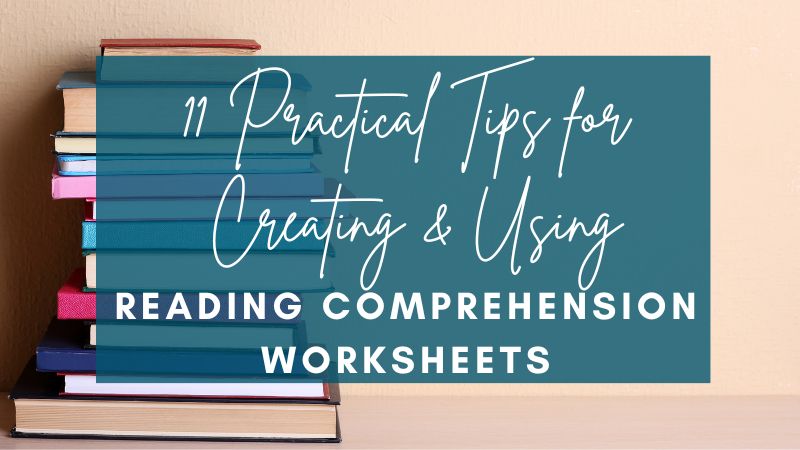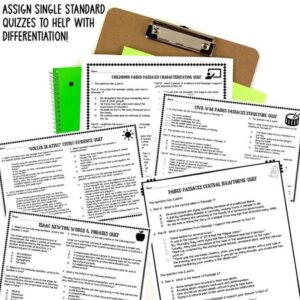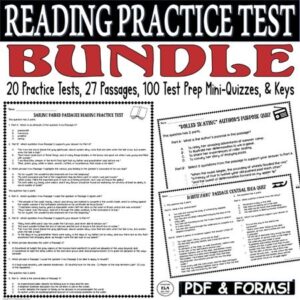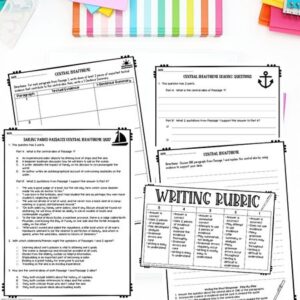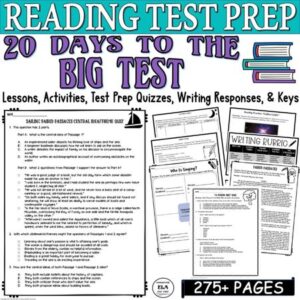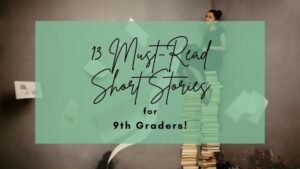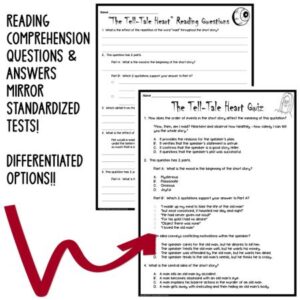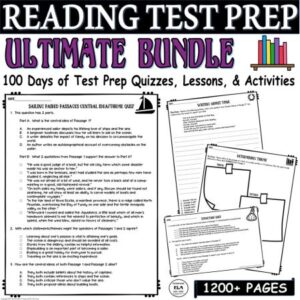The word “worksheet” has a bad rap nowadays. And honestly, I don’t really understand why. Worksheets simply have the “work” displayed on paper; they allow teachers to assess their students’ mastery of certain knowledge and/or skills. Ultimately, how is incorporating worksheet reading comprehension activities bad?
It isn’t!
I believe worksheets may have a negative connotation because they might be construed as “busy” work. Well, if the goal is to merely keep students busy, I totally get it; however, there are fantastic worksheet reading comprehension activities out there that help teachers teach and students learn more easily and effectively!
Keep reading for 11 Practical Worksheet Reading Comprehension Tips!!
Want readymade Worksheet Reading Comprehension Activities? Check out this FREE Pack of 3 Test Prep Activities to help students achieve success on standardized tests!
11 Practical Worksheet Reading Comprehension Tips

1. Use at-grade-level and/or above-grade-level reading texts for worksheet reading comprehension activities in WHOLE GROUP or SMALL GROUP lessons.
When it comes to independent reading, I am a big advocate for student choice. Students, and people will general, will usually read whatever they want or are capable of when given the choice independent of traditional education.
We as teachers, however, only get our students for about 3-4 hours a week. If we only read 6th-grade level texts in a 9th-grade class because our average student is reading on that 6th-grade level, we are not truly helping our students.
Here are my reasons:
- If you have ever seen students take a standardized test, you know that many give up partway through, feel overwhelmed by the timed element, or use the Christmas-tree method.
- Sometimes, students are going through a rough time during major assessments; these tough times can greatly affect outcomes.
- You are not meeting the needs of students who are at or above grade level in reading. Some students might be reading at a 2nd-grade level while others might read at a 10th-grade level for an average of a 6th-grade class reading level.
Instead, for any text you actually teach, I implore you to choose those that will help your students grow, develop, and challenge their abilities beyond their comfort levels!
2. Focus on only specific skills, concepts, and/or texts.
So many worksheet reading comprehension organizers ask students to fill out a TON of information. Instead, there should be a specific focus.
For example, you could assess a student’s vocabulary knowledge on your worksheet reading comprehension organizer. Or you could practice examining the textual structure of a certain short story.
There is no right or wrong way to format a worksheet reading comprehension organizer, but I most certainly prefer one that is focused and purposeful!
3. Give opportunities for repeated practice with similarly formatted worksheet reading comprehension activities.
I know, I know. The writer William Cowper claims that “Variety is the spice of life!” Overall, this proverb can be true, but when it comes to teaching and reinforcing skills and important concepts, we need lots and lots of repetition.
There is no need to reinvent the wheel every time. When students are familiar with an organizer or type of worksheet, they can attack the task at hand because they have “done” it before. They can get down to the work at hand rather than learning how to complete the activity in the way you want.
Reusing a specific organizer for various texts is, ultimately, SUPER helpful and effective!
Want test prep quizzes to help you teach reading comprehension? Click below!
4. Model what you want before students work independently.
I am a huge fan of the I DO, WE DO, YOU DO method. And it makes total sense.
I DO- Show students exactly what you want from them by modeling an exemplary response or example answer.
WE DO– Guide students as they work with you to create a response or answer a question.
YOU DO- Let students work independently, in pairs, or in small groups. You may want to start with pairs. Small groups tend to be louder and some students tend to lean too heavily on other students. Additionally, students may not be ready for independent work.
PRO-TIP: ***Keep your examples UP on the board and/or IN plain sight! You can point to them when students inevitably ask for help!
5. Grade or check the worksheet reading comprehension activity during student work time.
This process might seem a bit overwhelming at first, but the rewards are mighty!
Think about it. As you check the worksheet reading comprehension activity, it will save you loads of time in terms of grading and gathering data. Plus, it gives your students the opportunity to fix any errors. The ultimate goal is student learning, so if students can submit as soon as they are finished, it makes everyone’s job that much easier.

6. Utilize the worksheet only for 1 or 2 class periods (a short time period).
Many times, teachers will create packets of various reading comprehension activities, and unfortunately, this mass consumption has led to the belief that the assignment is just “busy work.” Instead of meeting or mastering the standard(s), the end goal is to finish the large packet of work.
Instead, make the worksheet reading comprehension assignment due by the end of class or by the next class period. If your students are anything like mine, they will lose their work on their way home, misplace it in a locker, or just disregard it.
Because I require work to be submitted daily, students have no excuse. I mean, you can always offer extra time to work on it at home…but just make a note of it in your grade book for parent/guardian knowledge.
7. Read directions for all worksheet reading comprehension assessments.
It might seem super basic to read directions with your students, but taking 3-5 minutes to read aloud the directions and write down student questions/answers on the board will go a LONG way!
I wish we could just assign and go on with our lives; however, students might need some ideas to be clarified, explained, or even revised because certain elements make no sense. I have had plenty of assignments in college that did not pass the comprehension muster test.
A simple reading and rereading of the directions, without spoonfeeding the answers, will help your students and give them no reason not to complete the assignment!
Need to save some time this week? Check out this paired texts activity bundle below!
8. Ensure that the worksheets align with the standards.
There are so many activities out there that SEEM to be relevant and rigorous. Just check out TPT for loads of options with varying perspectives on what makes a good reading comprehension activity.
You will find the following:
- Worksheets that are too difficult or too easy for a certain grade level
- Worksheets that only offer five minutes of actual work when it took you double that time to make copies
- Worksheets with too much design involved and serve to distract
- Worksheets that don’t require students to master a part or all parts of the standard
For example, let’s say you are trying to get students to identify the tone of a poem. You might want to define the word “tone” first; the standard does not really ask students to know the definition. There is MUCH more to the process of really knowing and understanding tone.
CCSS.ELA-LITERACY.RL.9-10.4
Determine the meaning of words and phrases as they are used in the text, including figurative and connotative meanings; analyze the cumulative impact of specific word choices on meaning and tone (e.g., how the language evokes a sense of time and place; how it sets a formal or informal tone).
The above standard is asking students to master several skills:
- Determine the meaning of words and phrases in a specific context.
- Differentiate between figurative and connotative meanings of words and phrases.
- Analyze the impact (effect) of the word choice on meaning AND tone.
To even get to the higher level skills, we need students to know some other things first:
- Definitions of figurative and connotative.
- How to analyze; this skill requires more than mere summarizing, which in itself can be tough for struggling readers.
- Understand that tones vary beyond formal and informal, although they will have to know these terms as well.
If the worksheet reading comprehension assignment asks students to ONLY identify the tone of a text, that is NOT enough to meet the standard. Even using evidence to support the tone is not enough either. We need students to get to the analysis part. How do the words/phrases affect meaning/tone? What is the overall impact?
I try to encourage students to go beyond these questions by asking “What is the purpose of the tone?” In literature, what message/theme is the author trying to get across through the use of a specific tone or change in tone? In an informational text, what is the purpose of the text and how does the author’s tone contribute to the purpose?
I wrote all of this to say that the focus of the lesson should ALWAYS be on the standards in SOME way!
Do you only have a month to prepare for the state test? Check out this 20 Days to the Big Test Reading Bundle!
9. Incorporate varied texts when applying skills and/or concepts for reading.
Students will come across varied genres as they read throughout their lives. You can include SO MANY options that are not classically taught as well as the classics!
- poetry
- songs
- newscasts
- podcasts
- blogs
- short stories
- plays
- videos
- reels
- films
- tax documents
- letters
- historical texts
- websites
- novels
- nonfiction books
- documentaries
The sky is the limit for texts to use with worksheet reading comprehension activities!
Need ideas for short stories? Click to read 13 Must-Read Short Stories for 9th Graders!
10. Make class set copies for worksheet reading comprehension activities to save time and your allotted number of copies.
When students write, they learn. There is NOTHING wrong with projecting the worksheet or making only class sets or small group sets for your students.
Printing off 150 copies every day even using the main copier can be quite costly. Instead, let students use blank paper or lined paper. They can even create their own “appropriate” and “creative” graphics to accompany their work!
If students work in pairs, that can even save you time grading as you only have to assess a single assignment for a pair of students.
11. Offer differentiated options for your worksheet reading comprehension assignments.
Differentiation is a HOT trend in education today and rightly so. We want to meet all of our students where they are, but it can become overwhelming and time-consuming.
If the goal is for a student to show that he/she has understood the reading, there are many ways to assess knowledge:
- Answer questions.
- Take a quick quiz.
- Write a summary.
- Discuss the text.
- Chat with another student.
- Create a visual of the resolution.
For example, if you have a quiz for “The Tell-Tale Heart,” you don’t have to give the same exact quiz to every student. You could change it up with worksheet reading comprehension quiz options!!
- Give 3, 5, or 10 questions instead of 20 questions for students who usually need extra time.
- Only assign questions linked to the standards a student or group of students is struggling with.
- Offer a digital version instead of a paper version (ex. Forms, Slides, Website).
- Let certain students use the passage to answer the questions.
- Include a written response option instead of a multiple-choice quiz.
- Allow student pairs or groups to work together on several questions.
- Encourage students to retake the assessment if they need it.
Why use Worksheet Reading Comprehension Activities?
They work! They can be fun! And, most importantly, they can be effective!
READING RESOURCES-
Need help with test prep this year? This High School Reading Comprehension Passages and Questions Test Prep Lesson ULTIMATE BUNDLE prepares upper middle and high school students for state exams and assessments (with informational texts, literary texts, and paired passages)!
It includes 100 EASY-TO-TEACH Reading Test Prep Lessons with Worksheets, Activities, Writing Responses, Passages, and Common Core Style Test Prep QUESTIONS and ANSWERS that integrate test prep into the teaching of literature!
Need more help with Worksheet Reading Comprehension Activities? Check out my store Kristin Menke-Integrated ELA Test Prep!

